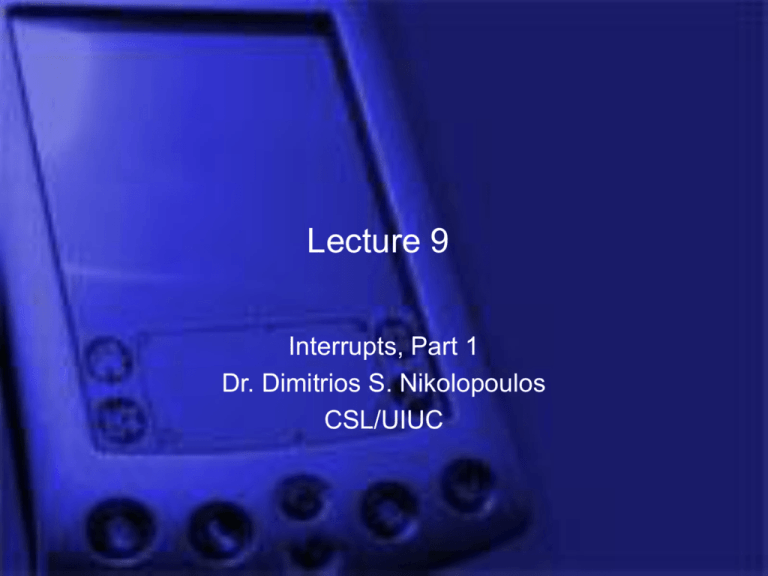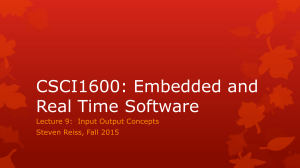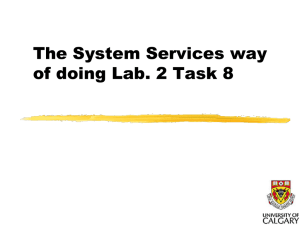ECE 291-Lecture 0
advertisement

Lecture 9 Interrupts, Part 1 Dr. Dimitrios S. Nikolopoulos CSL/UIUC Outline • • • • • The importance of interrupts Interrupt vectors Software interrupts Hardware interrupts 8259 Programmable Interrupt Controller ECE291 Lecture 9 2 Why are interrupts important • Interrupts let you use the operating system (run your programs, manage your files, access your peripherals etc.) • Interrupts help peripherals “talk” to your microprocessor • Interrupts help you measure time and control the timing of certain tasks in your microprocessors ECE291 Lecture 9 3 Interrupts from a pedagogical perspective • By learning interrupts you learn important concepts such as: – Concurrency: how your processor manages to service interrupts while your program doesn’t know anything about them and how multiple interrupts are serviced at the same time – Preemptability and priorities, how can a low priority-task be preempted by a high-priority task – Scheduling: how can we assure that both low and highpriority tasks get the service they deserve from the processor ECE291 Lecture 9 4 Interrupts and our everyday lives • We will spend at least two lectures to explain how to measure and track time in your microprocessor and you will be wondering why don’t we just look at our watches… • But we will also learn that looking at your watch all the time is not a good thing to do, especially if you’re a microprocessor… • We all have priorities – E.g. you do your ECE291 homework and your girlfriend/boyfriend calls, there’s a high-priority interrupt – While you talk to your girlfriend/boyfriend you get another incoming call from your mom, there’s an interrupt that you decide how to handle • High priority: put the girlfriend/boyfriend on hold • Low priority: put your mom on hold or don’t even bother to switch to the other line ECE291 Lecture 9 5 Interrupts…seriously defined • • Triggers that cause the CPU to perform various tasks on demand Three types: – Software interrupts – initiated by the INT instruction in your program – Hardware interrupts – initiated by peripheral hardware – Exceptions – occur in response to error states in the processor or during debugging (trace, breakpoints etc.) • Regardless of source, they are handled the same – Each interrupt has a unique interrupt number from 0 to 255. These are called interrupt vectors. – For each interrupt vector, there is an entry in the interrupt vector table. – The interrupt vector table is simply a jump table containing segment:offset addresses of procedures to handle each interrupt – These procedures are called interrupt handlers or interrupt service routines (ISR’s) ECE291 Lecture 9 6 Interrupt vectors • The first 1024 bytes of memory (addresses 00000 – 003FF) always contain the interrupt vector table. Always. Never anything else. • Each of the 256 vectors requires four bytes—two for segment, two for offset Memory address (hex) 003FC 4*x 00008 00004 00000 ECE291 Lecture 9 INT 255 INT x INT 2 INT 1 INT 0 7 Software interrupts • Essentially function calls using a different instruction to do the calling and different conventions • Software interrupts give you access to “built-in” code in the BIOS, the operating system, or peripheral devices • Software interrupts are triggered with the INT instruction ECE291 Lecture 9 8 The INT and IRET instructions • Syntax: INT imm8 • imm8 is an interrupt vector from 0 to 255 • INT does the following: – – – – Pushes flag register (pushf) Pushes return CS and IP Far jumps to [0000:(4*imm8)] Usually clears the interrupt flag disabling the interrupt system • IRET is to INT what RET is to CALL – Pops flag register – Performs a far return ECE291 Lecture 9 9 Things to notice • The interrupt vector table is just a big permanently located jump table • The values of the jump table are pointers to code provided by bios, hardware, the operating system or YOU! • Interrupt service routines preserve the flags – the state of the microprocessor before the INT should be completely unaltered by the ISR and your program must return to normal operation. ECE291 Lecture 9 10 Hardware interrupts • Alert the processor of some hardware situation that needs the processor’s attention – A key has been pressed – A timer has expired – A network packet has arrived • Same software calling protocol • Additional level of complexity with the interrupt “call” not coming from your program code • Can happen at any time during the execution of your program, invocations of ISRs for hardware interrupts are asynchronous ECE291 Lecture 9 11 The 80x86 interrupt interface INT Request (INTR) 80x86 processor INT Acknowledge (INTA) Some device Data bus • Device generates request signal • Device supplies interrupt vector number on data bus • Processor completes the execution of current instruction and executes ISR corresponding to the interrupt vector number on the data bus • ISR upon completion acknowledges the interrupt by asserting the INTA signal ECE291 Lecture 9 12 It is not that simple… • What if we want to connect more than one devices to the processor ? • What happens if multiple devices generate multiple interrupts at the same time ? • We need a way to share the two interrupt lines among multiple devices • 8259 Programmable Interrupt Controller • The 8259 PIC operates as an arbiter for interrupts triggered by multiple devices • One 8259 serves up to 8 devices, but multiple 8259 chips can be “cascaded” to serve up to 64 devices ECE291 Lecture 9 13 The 8259 PIC 8259 PIC 0 1 2 3 4 5 6 7 INTR INTA INT# ECE291 Lecture 9 Interrupt outputs from peripheral devices 80x86 14 Master-Slave Configuration Base vector is 08h 80x86 Master 8259 INTR ECE291 Lecture 9 0 1 2 3 4 5 6 7 IRQ0 IRQ1 Slave 8259 INTR IRQ3 IRQ4 IRQ5 IRQ6 IRQ7 0 1 2 3 4 5 6 7 IRQ8 IRQ9 IRQ10 IRQ11 IRQ12 IRQ13 IRQ14 IRQ15 Base vector is 78h 15 The 8259 PIC • PIC is very complex to program, fortunately the BIOS does most of the work needed • Programmed with the I/O address 20h-21h (master) and 0A0h-0A1h (slave) • I/O instructions yet to be discussed… – in reads from an I/O address – out writes to an I/O address • Consider them as two registers the status register and the interrupt mask register ECE291 Lecture 9 16 The 8259 PIC • The mask register is addressed from 21h • It lets you enable/disable specific hardware interrupts • Counterintuitive: a 0 ENABLES an interrupt and a 1 DISABLES the interrupt • Never load a value immediately to the mask register • Always read the previous value and use and/or instructions to set the new mask in al, 21h ; this one reads the value of the mask register and al, 0efh ; this zeroes out bit 4 i.e. IRQ4 out 21h, al ; this actually disables the interrupt in IRQ4 ECE291 Lecture 9 17 The 8259 PIC • When an interrupt occurs and the processor starts executing the ISR all further interrupts from the same device are blocked until the ISR issues an end of interrupt instruction mov al, 20h out 20h, al • You must end exactly one interrupt! – Not sending one will block all interrupts from the save device – Sending two or more means that you might accidentally acknowledge the end of a pending interrupt! • Two more registers track pending interrupts received at the PIC and interrupt priorities • You must be careful when you’re patching existing ISR’s (because the end instruction sequence may already be included in the ISR) ECE291 Lecture 9 18 The 8259 PIC • IRQ mapping – Interrupt vectors 8 through 0Fh map to IRQ0-IRQ7 – Interrupt vectores 70h-77h map to IRQ8-IRQ15 ECE291 Lecture 9 19 Interrupt vectors and the 8259 PIC Base vector is 08h 80x86 Master 8259 INTR ECE291 Lecture 9 0 1 2 3 4 5 6 7 IRQ0 IRQ1 Slave 8259 INTR IRQ3 IRQ4 IRQ5 IRQ6 IRQ7 0 1 2 3 4 5 6 7 IRQ8 IRQ9 IRQ10 IRQ11 IRQ12 IRQ13 IRQ14 IRQ15 Base vector is 78h 20 Typical IRQ assignments • • • • • • • • • • IRQ 0: Timer (triggered 18.2/second) IRQ 1: Keyboard (keypress) IRQ 2: Slave PIC IRQ 3: Serial Ports (Modem, network) IRQ 5: Sound card IRQ 6: Floppy (read/write completed) IRQ 8: Real-time Clock IRQ 12: Mouse IRQ 13: Math Co-Processor IRQ 14: IDE Hard-Drive Controller ECE291 Lecture 9 21 Interrupt priority • Lower interrupt vectors have higher priority • Lower priority can’t interrupt higher priority • Higher priority can interrupt lower priority – ISR for INT 21h is running • Computer gets request from device attached to IRQ8 (INT 78h) • INT 21h procedure must finish before IRQ8 device can be serviced – ISR for INT 21h is running • Computer gets request from Timer 0 IRQ0 (INT 8h) • Code for INT 21h gets interrupted, ISR for timer runs immediately, INT21h finishes afterwards ECE291 Lecture 9 22 Priority in the 8259 • • • • • • 8259 supports several priority schemes On PC’s the 8259 uses the simplest form of fixed priorities Each IRQ has a fixed priority Lower IRQs has higher priority The timer interrupt (IRQ0) has lower priority than any other IRQ If you really need higher priority than the timer (e.g. connecting a nuclear reactor to your microprocessor) it is possible to use a NMI (non-maskable interrupt) • NMI has the highest priority among all hardware interrupts and cannot be disabled by the program ECE291 Lecture 9 23 Interrupt enabling/disabling • You can enable/disable all maskable hardware interrupts • The CLI instruction disables all maskable hardware interrupts • The STI instruction enables all maskable hardware interrupts • Be very careful if you ever need to use them – Many deadlock scenarios! ECE291 Lecture 9 24 The ugly details • ISRs for hardware interrupts clear the interrupt flag at the beginning to disable interrupts. They may include a STI instruction if they want to enable interrupts before they finish – It’s all about performance! Keeping interrupts blocked for long is a BAD IDEA • ISRs for software interrupts do not disallow hardware interrupts automatically at the beginning. If an ISR for a software interrupt needs to do that it must issue a CLI instruction – This is what most ISRs do – Again for the sake of performance a STI instruction must be issued as soon as possible – Note that when interrupts are enabled the priority rule applies • • The CLI works only for maskable hardware interrupts Code enclosed between CLI/SCI is often called a critical section, an uninterruptible piece of code ECE291 Lecture 9 25 Is there a way out of this mess ? • In many critical section situations (e.g. patching the interrupt vector tables) DOS helps us ensure the required atomicity • Convenient calls for – Safely getting the value of the interrupt vector from the interrupt vector table – Safely storing a new value to the interrupt vector table (patching the interrupt vector table) • In all difficult situations always examine what if scenarios – What if a hardware interrupt occurs at different points of our ISR ? – Identify the points that need to be protected and protect them with CLI/STI ECE291 Lecture 9 26 Servicing a hardware interrupt • • Complete current instruction Preserve current context – PUSHF Store flags to stack – Clear Trap Flag (TF) & Interrupt Flag (IF) – Store return address to stack PUSH CS, PUSH IP • Identify Source – Read 8259 PIC status register – Determine which device (N) triggered the interrupt • Activate ISR – Use N to index vector table – Read CS/IP from table – Jump to instruction ECE291 Lecture 9 • Execute ISR – usually the handler immediately re-enables the interrupt system (to allow higher priority interrupts to occur) (STI instruction) – process the interrupt • Indicate End-Of-Interrupt (EOI) to 8259 PIC mov al, 20h out 20h, al • Return (IRET) – POP IP (Far Return) – POP CS – POPF (Restore Flags) 27 Interrupt service routines • Reasons for writing your own ISR’s – to override the default ISR for internal hardware interrupts (e.g., division by zero need not terminate the program) – to chain your own ISR onto the default system ISR for a hardware device, so that both the system’s actions and your own will occur on an interrupt (e.g., clock-tick interrupt, measure elapsed time) – to service interrupts not supported by the default device drivers (a new hardware device for which you may be writing a driver) – to provide communication between a program that terminates and stays resident (TSR) and other application software (maintain your ISRs) ECE291 Lecture 9 28 Impact of interrupts on performance • The frequency of occurrence and the latency of the ISR determine the impact of servicing interrupts to your program • The latency of the ISR is non-negligible! • You may not notice it but you may be interrupted several times while executing your program. The good thing is that you don’t notice it! • Always remember: – When the processor starts executing an ISR there might be other ISRs executing already – Your ISR may be interrupted by a higher-priority interrupt – Many devices expect low latency from your ISR (imagine what happens if you hit a key in the keyboard and wait for a minute!) – Even those devices with high latencies (e.g. the disk) are not allowed to block other activity in the processor for long ECE291 Lecture 9 29 Bottom line YOUR INTERRUPT SERVICE ROUTINES MUST BE SHORT AND ACHIEVE THEIR PURPOSE WITH THE MAXIMUM EFFICIENCY! NEVER BLOCK THE SYSTEM WITH YOUR ISRs Interrupt Service Routines • ISRs are meant to be short – keep the time that interrupts are disabled and the total length of the service routine to an absolute minimum – remember after interrupts are re-enabled (STI instruction), interrupts of the same or lower priority remain blocked if the interrupt was received through the 8259A PIC • ISRs can be interrupted • ISRs must be in memory – Option 1: Redefine interrupt only while your program is running • the default ISR will be restored when the executing program terminates – Option 2: Use DOS Terminate-and-Stay-Resident (TSR) command to load and leave program code permanently in memory ECE291 Lecture 9 31 Interrupt Driven I/O • Consider an I/O operation, where the CPU constantly tests a port (e.g., keyboard) to see if data is available – CPU polls the port if it has data available or can accept data • • • Polled I/O is inherently inefficient Wastes CPU cycles until event occurs Analogy: Checking your watch every 30 seconds until your popcorn is done, or standing at the door until someone comes by • • • • Solution is to provide interrupt driven I/O Perform regular work until an event occurs Process event when it happens, then resume normal activities Analogy: Alarm clock, doorbell, telephone ring ECE291 Lecture 9 32





